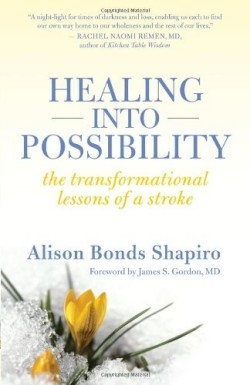Healing into Possibility
The Transformational Lessons of a Stroke
Stroke survivors experience varying degrees of suffering and different levels of damage to different parts of the brain. The result is different kinds of disability with which they must thereafter cope.
The author, a California businesswoman active in real estate, suffered two major strokes, brain-stem hemorrhages, only twenty-four hours apart in 2002. This book is an account of her recovery, in particular what she learned in the process and how she subsequently applied those lessons to her life.
In 2002, many physicians were still telling stroke patients that they had only about six months to make their recovery, to recoup their losses; beyond that point, Shapiro was told, she “might have incremental improvements, but that will be it.”
Physical therapists, of course, help immensely, as they almost always do. This is true even when patients are annoyed by physical therapists enthusiasm and persistence in pressing patients to take a more active role in their own rehabilitation. “Kick that leg out!” or “Raise that arm higher!” they might say.
Shapiro assumed primary responsibility for her rehabilitation, basing it largely on her grasp of the events that had taken place inside her brain. Positive results fueled her determination to persevere and to achieve as much as she possibly could, concentrating at last on her left foots inability to perform consistently one of the more subtle motions associated with walking.
At that point, Shapiro came upon a copy of The Brain That Changes Itself by Norman Doidge, MD, in which she found that some of her own assumptions about working ones way back after a stroke had been confirmed, measured, and scientifically validated.
“All too often,” she says, “those of us who managed to get a lot of function back were considered the exceptions to the rule, the miracles. I dont want to be a miracle. I want to be evidence to somebody else that transformation is possible.”
A central metaphor and a central message of Shapiros book is that “brains are, biologically, expensive real estate. Leaving them vacant is wasteful.”
Recent studies use the term “neuroplasticity,” or simply “brain plasticity,” to describe the brains formerly underestimated abilities to compensate for a strokes damage by reassigning “duties” to undamaged areas and developing new areas to handle additional work. The message to stroke victims is that even if they stopped trying at the six-month mark to regain lost functions, their brain persevered. (June)
Note: The reviewer, Harold V. Cordry , was a journalism professor and a professional musician with the Kansas City Symphony before he suffered a stroke in 2000. Now retired and living in Tecumseh, Kansas, he remains mostly paralyzed, but has produced several reference books.
Reviewed by
Harold Cordry
Disclosure: This article is not an endorsement, but a review. The publisher of this book provided free copies of the book to have their book reviewed by a professional reviewer. No fee was paid by the publisher for this review. Foreword Reviews only recommends books that we love. Foreword Magazine, Inc. is disclosing this in accordance with the Federal Trade Commission’s 16 CFR, Part 255.

